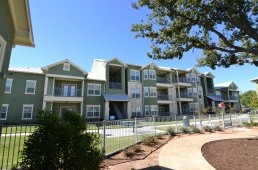
August 17, 2018 | by Laura Ross
Categories: Rental Housing
Housing Tax Credits can play a big part in making rental housing more affordable for tenants.
Freddie Mac recently conducted a study that showed tenants of properties funded by Low-Income Housing tax Credits (LIHTC) pay lower rents than low income households living in comparable market rate rental housing.
The study looked at rental trends in nine different metro areas over a six-year time span from 2012 to 2017. In 2012, rent at the average LIHTC property was only slightly more affordable than rent at the average market rate property. Since then however, market rate rents have risen much faster than tax credit property rents leaving a 38% difference between the two in 2017.
How are LIHTC and market rate rents determined?
At LIHTC properties, rent is set by the US Department of Housing Urban Development (HUD) using one of two methods. The first method bases rental rates on 60% of the area median income (AMI) and assumes that 30% will be applied to rent with an adjustment for the number occupants. The second method uses the fair market rent approach which bases rents on 40 percent of the fair market rent for a two-bedroom apartment. This method is typically used in areas with higher housing costs compared to the area median income.
In comparison, market rate rents fluctuate based on supply and demand of the local market. Across the 9 metro areas looked at in the Freddie Mac study, market rate units have increased between 1.6% and 7.9%, averaging at a 5% increase per year. During the same period, rents for tax credit properties increased an average of 0.9% per year. A tenant in a 2-bedroom market rate unit spent an average of $7,500 more per year in rental expenses than a tenant in a similarly sized tax credit-financed unit in 2017.
While renters in LIHTC properties generally pay less in rent, the Freddie Mac article also states that LIHTC property rents could increase more dramatically than seen in recent years.
That said, renters in LIHTC property units continue to fair much better than those in market rate units. They enjoy the benefits of lower monthly rent and a more predictable rent growth.
The Texas Department of Housing and Community Affairs (TDHCA) administers to LIHTC program for the state of Texas. Click here to learn more.
On the House blog posts are meant to provide general information on various housing-related issues, research and programs. We are not liable for any errors or inaccuracies in the information provided by blog sources. Furthermore, this blog is not legal advice and should not be used as a substitute for legal advice from a licensed professional attorney.
TSAHC reviews all blog comments before they are posted to ensure a positive experience for our online community. Off-topic comments; hostile, derogatory or deliberately insulting comments; and comments specifically promoting goods and services will not be posted.
Approved comments will be published in their entirety. Personal information will not be removed unless it pertains to someone other than the person submitting the comment. For more information, please see our Comment Posting Guidelines.
To remove a previously submitted and published comment, please contact Anna Orendain at [email protected].
If you have a question regarding any of TSAHC's programs, please contact us.

Let’s just hope that the rent wouldn’t increase.